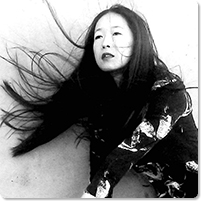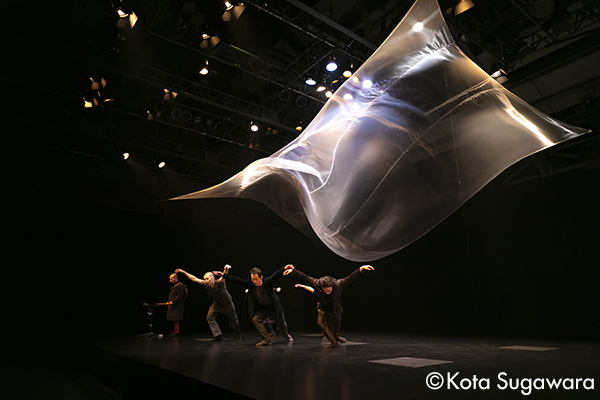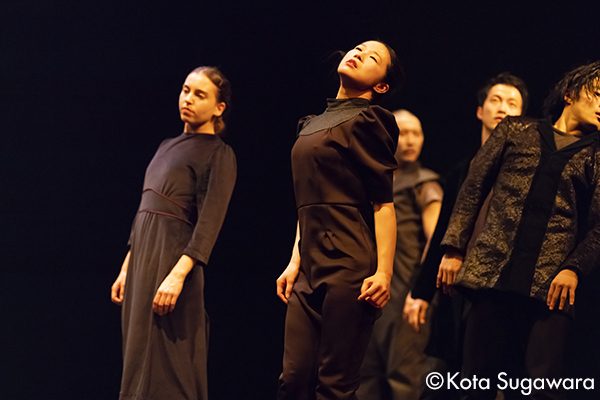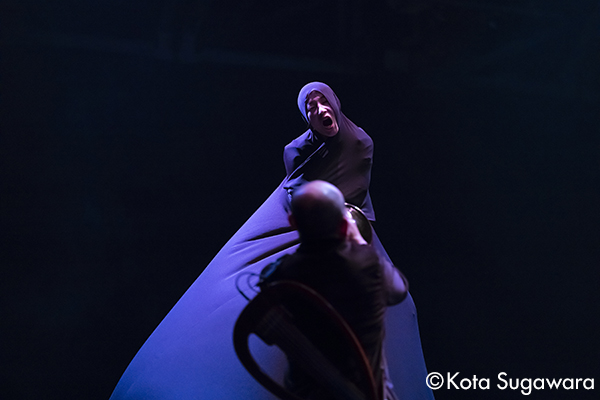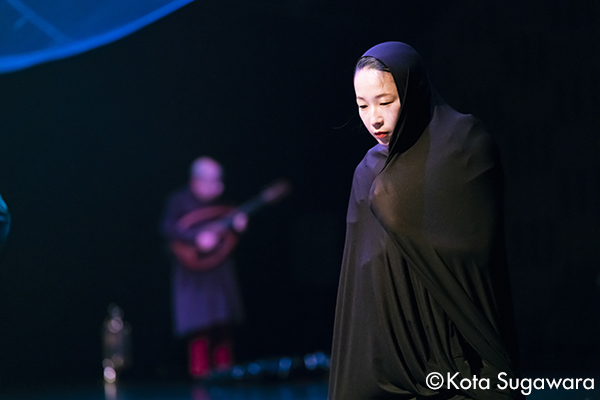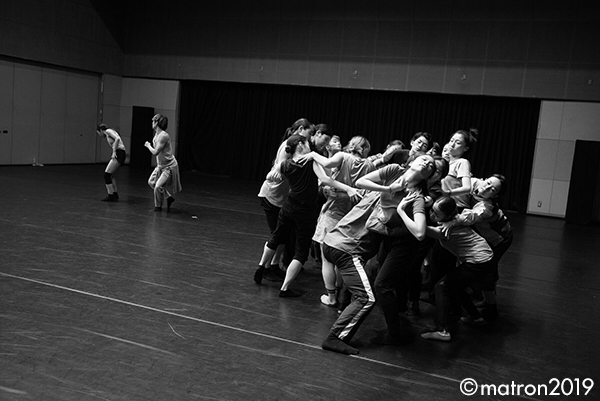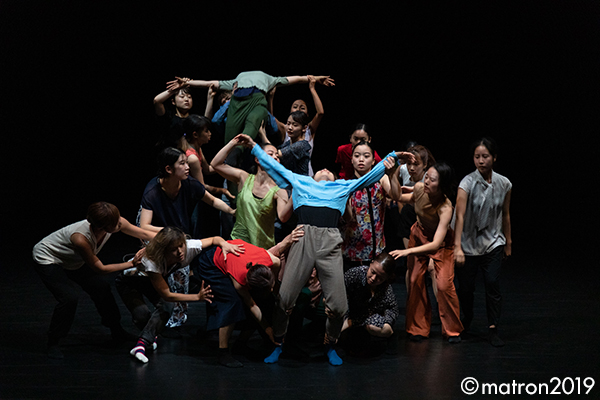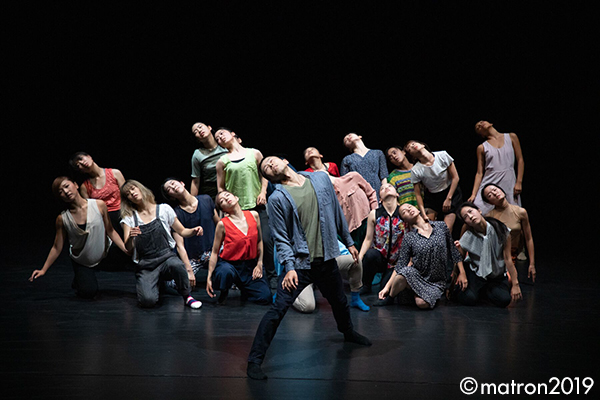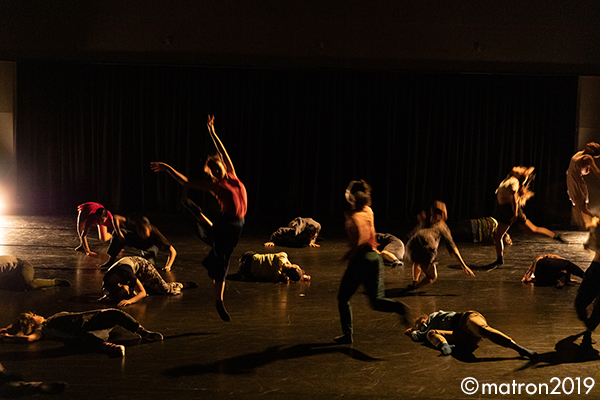Activities on the International Stage
- Since you resigned from your membership with NDT (*1) in 2015 and went independent, you have received offers to work in projects around the world. Could you give us a picture of the projects you participated in in 2019 as an example?
- The year began with my first participation in the YOKOHAMA DANCE COLLECTION as a dancer in the piece Futuristic Space choreographed by Ella Rothschild. Then, I returned to Europe and danced in Sidi Larbi Cherkaoui’s (*2) dance work Nomad in Belgium in February and stayed on for rehearsals for the new opera work Alcest that Larbi was commissioned to do for The Bavarian State Opera (Bayerische Staatsoper). After returning to my home in the Netherlands for a while in March, I danced in the performance of Nomad in Italy. In April, I came back to Japan for a while to attend the Japan Dance Forum Awards Ceremony. Then I went to Munich for two and a half months for more rehearsals and then the premiere of Alcest. In the latter part of June, I did a one-week residence in Japan at the Kinosaki International Arts Center to do research for the XHIASMA project with fashion designer Tamae Hirokawa, technical director Yutaka Endo, performer Mitsuko Takeuchi, the band World’s End Girlfriend and others to do a performance of a work in progress. In July, I stayed for five days at Kamiebi-ike in Niigata, is a so-called marginal village, where the fact that half the population is over 65 makes village sustainability quite difficult. There we did a workshop for the people of the village and the surrounding area at an arts space called Yamakiwa Gallery in a converted old farmhouse. Then I went back to our family home in Hiroshima and I worked on the creation of a new piece with Hiroshima area dancers for the “TRY A DANCE” program to be held in November organized by ASTER PLAZA, and we held workshops with auditions for it. Then I returned to Munich for the last performance of Alcest, and from the latter half of July I served as an instructor for the NDT Summer Intensive program in the Netherlands. In August, I returned to Japan and did a guest performance at the ballet school I used to attend in Hiroshima, and after that I did two weeks of workshops until the 31st at Saitama Arts Theater for the Saitama Dance Laboratory Vol. for young dancers. Then through all of September and October we had rehearsals and the performances of the Bunkamura production of Oedipus directed by Matthew Dunster (starring Ichikawa Ebizo, Hitomi Kuroki and Mirai Moriyama). In November, I danced live in the performances of the band World’s End Girlfriend, who had done the music for my solo piece media that premiered in 2018. Then I went to Nagasaki and performed the premiere of my original solo piece taking pearls as its theme at Ōmura Bay, which is said to be the bay where cultured pearls were first successfully cultured, and I was asked to create the piece by an artist from Kyushu who is sad to see the decline of the industry there. Finally, I went to Hiroshima to do the final rehearsals and performance of our work for TRY A DANCE.
- That is certainly a very impressive and demanding schedule! After you left NDT and went independent, you became a registered dancer of EASTMAN, Sidi Larbi Cherkaoui’s production/promotion company. What kind of an organization is Eastman?
- Eastman is based in Belgium and it represents a group of registered artists, not only dancers but actors, composers, photographers and musicians as well. When Eastman gets a project for dance or opera, Larbi chooses the artists and then begins work on the production. Eastman has so many registered artists, but for dance in recent years it is usually the same 15 or so artists who will be involved.
- In Japan’s movie industry in the past, a famous director would often have a group of the same cinematographers and technical staff working under him/her that came to be referred to as the “such-and-such team.” Is that the kind of feeling with the registered artists of Eastman?
- Well, yes. I am told that the name Eastman is a direct English translation of Lardi’s name Cherkaoui, so it really is the “Cherkaoui team.” The artists who are on one-year contracts with Eastman are said to be very busy, but I work on a separate contract for each project, so I feel very little constraint.
- You started modern ballet at the age of eight and that led to your beginning study of classical ballet at the Mieko Ikemoto Ballet School at the age of nine. In middle school, you also attended ballet lessons in Kyoto, and in your second year of high school you went to Monaco to study at Princess Grace Academy. After graduation in 2004, you became a member of NDT? and advanced to NDTI in 2006, and it was there that you established your career foundation that continues to this day. After joining NDT, was it difficult acquiring the expressive qualities and technique required there?
- Before I went to Europe to study, I saw a television broadcast of an NDT performance at Saitama Arts Theater when they came to Japan, and I thought it was wonderful. From that time I had a dream of someday being able to move like the NDT dancers. When I finally joined NDT, I didn’t really feel much difficulty in terms of re-training my body having trouble with certain movements that were different from my classical ballet training, but I did have some difficulty breaking out of the patterns of movement or thought processes that I had acquired until then. My fellow dancers there (at NDTII) were all wonderful people, and although there was some element of competition between us all to move up to NDTI, there was a very good sense of unity as a group.
- Was that the result of the company philosophy instilled by the former artistic director Jiri Kylian, who was at that time the resident choreographer and artistic advisor?
- I think it was. Kylian, got rid of any hierarchy based on seniority or number of years in the company, and eliminated discrimination based on gender, race or nationality as well. I think it was also by means of not hiring people with those kinds of discriminatory attitudes. At the time, it was the rule that even if we were third cast or seconds, we had to be at the rehearsals all day and watch the others rehearsing. If that was for the better or worse, I can’t say, but I certainly did learn a lot from watching the others. For example, even it they were dancing the same role, Kylian would never give two different dancers the same instructions, and he never expected the same thing from different dancers. You could feel clearly how he respected the individual, and that attitude has had a big influence on me.
- What kinds of advice or instructions did Kylian give to you?
-
When I was there, Kylian was nearing the end of his term as resident choreographer and artistic advisor. At the time, his works broke down existing forms and had become increasingly abstract, and most of the pieces were generally considered difficult to understand. The instructions that he gave us dancers were mostly about feelings and images. He always spoke to us about all five of the senses, from the visual and aural and also smell and tactile qualities and things like that.
One of the instructions from Kylian that left a clear and strong impression on me was for his piece Toss of a Dice. In this piece, a sculpture created by the Japanese sculptor Susumu Shingu that moved at acute angles as a dominant presence was hung from the ceiling, and the dance took place beneath it. In the end the group of dancers all collapse and it becomes a solo dance performed by me while the pointed sculpture is gradually lowered and I did an improvisational dance trying to avoid contact with it, and what he told me was that this huge thing that could not be stopped was coming down and if it touched me I would die. However, besides the fear of what this object represented, there was also a feel of deep love and awe for it. This was of course a very abstract approach he was asking for. For the duet dance before this solo, the instructions he gave were also very abstract. The choreography called for many shifts between movements with gentle and soft feeling to movement that became very sharp, which required the dancers to have within themselves very different feelings and a multiple personality syndrome type aspect and to be able to switch between them instantly to create changes in the physical impressions and feelings projected. In this sense I felt he was a choreographer who always asked for outward expression of the relativity of things and the diversity and multi-faceted nature of human beings. - It means that to dance Kylian’s choreography required plenty of soul searching within yourself, didn’t it?
- You find yourself thinking very often, “What would I do in such a role?” Rather than being a search for your own identity, it is to have a dialogue with your true, full-sized self at that moment and come up with movement that based on the scene’s feelings and thoughts. With Kylian and the other choreographers, you are being asked to take the choreography into yourself and hold it there. It is not just a task of performing the choreography you are given, but to chew on it until you are able to add your own color to it. That is why, as I watched my partners or the group in rehearsals I would always think about what feeling I would bring to the role and how I would respond to each situation.
- Do you feel you are better suited to that kind of work where it is the thoughts and input of the individual that are valued, rather than simply dancing as you are directed to?
- I can be quite selfish, so it is hard for me to just do as I am told (laughs). But when I am told to bring my own movement to a piece, you can’t do that if you don’t know yourself but, fundamentally, truly understanding yourself may be something that you can never do completely no matter how long you spend at it. It is difficult to see your own strengths and weaknesses and your unique peculiarities, although it’s possible to bring them out from time to time. But, I believe it is something that is definitely important, were I dancing classic ballet or, for example, if I chose to do some other work than dance. Of course, there are some dancers who don’t think about it and, in fact, at first I thought it was a bother, and I just wanted someone to tell me, “Dance it this way.” However, when I was asked, “In order to get the piece from this point to the next point, how would you do it?” I realized that it wasn’t enough just to do it in line with the choreographer’s concept, and instead I needed to bite into it, chew it and digest it before I could bring out something that was meaningful and mine at the same time. It is a long process that takes a lot of time, but without that process, a dancer is no different from a gymnast, who just has to get through the routine, copying it perfectly as it is choreographed with no individuality to be seen.
- Weren’t you also influenced positively by some of your fellow dancers at NDT?
- One dancer of wonder talent who influenced me tremendously was Idan Sharabi. He is Israeli and had gotten an offer to join from Ohad Naharin to join the Batsheva Dance Company, but he wanted to study with Kylian, so he came to NDTII instead (and joined Batsheva later). I was in NDTI at the time, so we didn’t have many opportunities to meet, but later he asked me to dance in one of his pieces, and so we danced together in his duet at a workshop performance for NDT dancers. Although he had objections to my movements and we fought often, I fell for his sense of music and the meaning he brought to his work, so dancing with him became a joyful and rewarding experience. I feel that brought a big change in my awareness.
- What kind of a piece was it?
- The music he had chosen was a very common Chopin piano piece, and I thought at first, “Are you really going to use this?” But when I saw the ideas, feelings and images he brought to that piece I had heard so many times, it was a real revelation for me. The great variety and diversity of colors and textures he brought to the melody and the tremendous shifts from texture to texture brought new discoveries for me in that music I was so used to hearing. All dancers who perform in Ohad Naharin’s works will first go through his Gaga movement training (*3) and Idan’s physicality is of the gaga type that seeks to take the dancer from zero to 100, or even beyond that to 1,000 in one leap. There was always a feeling that a sudden change came from the inside. Before I became used to it, I imagined what the feeling was like, and when I would move with that tentative uncertainty, he definitely seemed to dislike that and told me again and again that it was no good. I realized that if didn’t have a clear image in mind, you couldn’t explode from zero into the movement. It was very violent motion that put a big strain on the body, but amazingly I never got injured doing it. After that, I was invited to take part in a project Idan had started in Israel. Gaga was originally a movement method that Ohad started in order to recover from an injury himself, so if you are thoroughly warmed up by practicing the method, you can jump from zero to 1,000 without causing dangerous strain on the body. Having met Idan changed the way I used my body and my physicality tremendously.
- As a dancer, your movement looks unique and different from ballet or modern or contemporary dance. We feel subtle changes in your center of gravity, and it seems like the textures you project are actually close to Butoh. It’s not like the movement of bones and muscles but like a sandbag shifting with the feet sliding.
- When I teach workshops recently, I often use the movement of a slug as an example. It is things like the sense of the film of sticky substance that is left after the slug passes. I say things like, “Imagine a slug in your mind. Become a slug in this part of your body, then massage various parts of it using the floor.” I then have them do a warmup exercise that involves lying on the floor facing upward and imagining their head alone is a slug and, while changing the one point on the back of the head that contacts the floor, use it to rub the floor. Then, while keeping the image of a slug’s movement, to move the other parts of the body and massage them against the floor one after another. This method of leading the people’s movement with words rather than giving them forms to follow is close to the gaga method. What is interesting about gaga is that you use words, but each of the people will get a different image from each word, so the movements that come out in response to them are multifarious. That is a methodology I learned from Ohad’s gaga.
- Would you tell us when you first had a performance of a dance piece you choreographed yourself?
-
Of my solo works, the first was the short piece titles samsara I choreographed in 2010. As for the first work that I didn’t dance in, it was the short duet titled Gently Disturbed that I choreographed for NDT dancers in 2012. It was a “tryout” work, for which I worked out most of the movement myself and then gave it to the dancers to add changes to, and for the performance I did things like adding video images of the dancers I had taken myself.
A change came in my working method in 2014, when I created the piece White Sins in two weeks during the NDT Intensive program. It was a group dance for about 20 of the Intensive students. It was for this piece that I began a new method of having the dancers create movement from a tasks I gave them, and then I looked at the resulting movements and said to myself, such-and-such a feeling might go well with this movement, or that movement might fit such-and-such a scene. In that way I created scenes, and that working process became like the origin of the working method I use now. Since then, this is the method I use when choreographing for people other than myself. - Is Kylian the choreographer who has influenced you most?
- Of course I have been influenced the work of Kylian in a number of respects, the biggest influence has come from Crystal Pite(*4). Pite gives you work tasks that are completely emotion-free. Take for example the case of last year’s Saitama Dance Laboratory, where the tasks I gave included “the movement of ribbons,” “up-down movement,” “twisting movement” and “movement involving touching your own body.” They are tasks completely free of emotions of thoughts that give birth to pure movements from which to begin to build on. This is something I learned from creative sessions with Pite. Of course, she has within her very concrete concepts, but she deliberately avoids communicating them to the dancers in the early stages of the creative work. There are of course times when on the first day she will say a word or two about the kind of work she wants to create, but it is always a very vague concept she cites. Probably, by not giving the dancers a clear image in that way, she is able to avoid limiting the world view they bring to the work in hopes of bringing out choices of larger-scale movements. I have been greatly influenced by that kind of method that leaves to outcome so unpredictable.
- Just a look at your 2019 schedule gives us an idea that you have been active recently, both as a performer at times and at other times as a creator working on a diverse range or projects. How do you deal in your mind with such a schedule of activities at are often so different in nature?
- I love working as a performer. Both in Oedipus and with Eastman, I have been a performer, but with opera and theater projects, they have other aspects not usually found in regular dance works, and that is also very interesting for me. With Oedipus, I found talking to the director, Matthew Dunster, in the rehearsals very inspiring, and that connects on to other things later. Performing itself is a form of work that is basically output, but I always absorb a lot from the working process up until the performances, so I think of being a performer as valuable input time that I benefit from. With opera as well, it is very inspirational for me to see the dynamics of the large integrated world involved in opera. Also, in the case of commercial theater projects like when (Lardi) Cherkaoui staged Pluto (an adaptation of Naoki Urasawa’s manga), the scale of the production, with its actors and stage art, is larger than dance productions, so there was so much that I learned from it.
- In recent years you have worked on a growing number of projects as a choreographer as well, which gives us here in Japan a chance to see more of your choreography works
- The connections that have brought me these opportunities to choreograph works all link back to NDT, and in particular the opportunity to perform in Tomoko Mukaiyama’s work HOME(*5) in 2016 at the Saitama Triennale was pivotal. I was still in my teens went I moved from Hiroshima to study in Monaco, and then I went straight on to NDT, so I had almost no contact with Japan’s dance world or the people active in Tokyo. But it happened that the chief producer of Dance New Air had seen HOME and asked me to create a piece for the 2018 Dance New Air pre-festival program. That also led to many connections to other people, and my opportunities grew and grew after that.
- Had you worked with Mukaiyama-san from your time in the Netherlands?
- Among Kylian’s works was a wonderful one titled Tar and Feathers in which Mukaiyama-san played a live performance, and I was also able to dance in that work, but there was no further connection after that at the time. However, when I performed the duet Breakaway that I created together with Kojiri-san in Amsterdam, Mukaiyama-san came to see it. After the performance, she came to me and said that if I was going to be leaving NDT, why don’t we work on something together. That is what connected to the work HOME. It was at a time when I had reached a creative block, but once I decided to let myself be led 100% by Mukaiyama-san’s directing and immerse myself that world, the resulting work turned out to be something that I loved completely, like a newborn child. Like with Gaka (Song of Songs)(*6), working with Mukaiyama-san was fascinating, but it was also very demanding, because every time I had to find some breakthrough element. But I think that that is an important element in every truly interesting work. Because it was a work that I could never have created by myself, I was grateful for the experience, and it also changed my values.
- Mukaiyama-san is an artist who makes feminine nature a theme in her work. Did working with her bring something different for you?
- Very much so, I feel. I think that in some ways I had probably been negating my own femininity, and prior to that I didn’t really like femininity. But I feel that I became able to respond positively to both the feminine and the masculine aspects inside me. With HOME, when Mukaiyama-san to me to do a part in a sexy and womanly way and I tried to do it, she would say, “That’s not sexy at all!” (laughs) So, in order to bring out that feeling, I had to search for that aspect in myself. Later, this femininity became an important portion of my solo work I created for Opto titled media, which explored the concepts of the body as a medium and the multi-faceted aspects that I found in myself. In that piece, my costume was all-knit body tights, which accented the body line visually and meant that I couldn’t hide my feminine nature. It was a piece that probably I could not have created several years before that.
- So, the input you receive as a performer is then reflected in tour creative work, isn’t it? The work enchaîne (a chain-like succession or connection in French)(*7) that you presented at Dance New Air in 2018 was a collaboration with the architect Tsuyoshi Tane and fashion designer Tamae Hirokawa. It was a beautiful work that took as its theme “bonds” transcending time and place.
-
Tane-san often came to see the NDT performances when he was still living in London about 16 years earlier, and we had said it would be nice if we could work together on something in time. The venue for the performance was The International House of Japan that had been jointly designed by three architects, so I decided to invite Tane-san to join the project to bring an architect’s perspective to it. Hirokawa-san had seen me perform in HOME, and that is how we got to know each other. I thought that Hirokawa-san’s “skin series” of seamless knit fashions would be perfect for dance, so I used it for my costume. After WWII, The International House of Japan was built as a place to promote the desire for cultural exchange between nations. I believe that dance has the power to do just that, so I wanted to create a work on the theme of bonds.
Around the time I was starting to work on the piece, I was performing the Mats Ek production of Juliet and Romeo in Sweden and then in Lardi’s opera production in Berlin and PLUTO, so was working with a lot of dancers and I decided to interview them and ask them about themselves. It wasn’t as if I tried to guide the subjects they spoke about, but they told me told a great variety of things about their lives. They told me things like that their families were immigrants, and about the war in the Philippines. There is the present, the past and the future, and although we are living today, but beneath this present world we live in, there are many things that have made it the way it is. As a dancer, I travel to many places and have met people who are important to me, but the people of the past, who are our respective ancestors, may have gone to other countries for the purpose of waging war and killed each other. And although the act of crossing borders into other countries is the same, the circumstances were completely different. But it was not all to negative effect, and in fact all things are connected in complex ways, and in that intricate weave of things, this dancer exists in front of me right now. I heard many such sadly cruel but amazing stories. And this experience made me feel that I wanted to take the fact that each of their circumstances should be seen as a different perspective and express that in the dance I create.
I made enchaîne a work consisting of a 30-minute installation of random video recordings of dancers and 30 minutes of dance. Tane-san and Hirokawa-san used her seamless material and other devices to make a set and costumes to create an image of a world covered in something like a cocoon with the dancers connected by chains made of red rubber bands in the image of bonds. The two dancers other than me had never met before, and after they arrived at the venue, we began making the movements working from a shared timeline and thought orientation. We only had three days from the time we started working at the venue until the opening performance, but everyone brought ideas to the process that helped me throughout the process. So, I feel that this was truly a piece born of working “bonds” to the end. Someday I would like to brush it up and refine it for a return performance. - From 2018, you have worked as an instructor with fellow former NDT dancer and Opto member Kenta Kojiri in the Saitama Arts Theater’s roughly two-week program for young dancers, the Saitama Dance Laboratory. We would like to ask you to tell us about the original piece Jardin Féerique performed on the final day of the program as the result of the two weeks of work. The piece solos performed at the end of the first program in 2018 had appeared to be based on the concept of the individual and opposed to the group.
- For solos, I was thinking about what we could do with the 24 dancers in the program, and instead of deciding on an overall framework, we built a work by exploring the relationship between the individual and the group and/or their contrasting elements. In 2019, I started only with a decision to use a particular piece of music. About two weeks before the start of the Dance Laboratory, a fellow member of Eastman had me listen to the piece Le Jardin Féerique conducted by the the conductor of Lardi’s opera, and I decided intuitively that this was the music I was going to use. As I listened to it at length, I envisioned a scene and got an image I wanted to work from. But since it was only a short four-minute piece, I decided I would create a different scene to precede it.
- The piece Le Jardin Féerique is the fifth in the suite Ma mère l’oye that Maurice Ravel wrote inspired by Mother Goose. What was the scene that you envisioned from it?
- When I was at the airport, I got a message with a YouTube URL from my fellow Eastman member saying it was a good performance that I should listen to. When I played it in the crowded airport, suddenly all I could hear was this beautiful music. All around me there were people doing their own thing, there were people getting angry, people feeling sick or irritated. Listening to the music in the midst of that, the surrounding confusion was reduced to the level of mere information input, and to me, in my state of complete immersion in the music, it all felt to me as one beautiful scene. That was because even the negative elements are something that we can only experience because we are alive. That was the image, but I felt that it was still so vague that it would be hard to communicate to the dancers. Also, I feared that if I stated some emotional or conceptual orientation from the beginning, I would only get movement influenced by that orientation from the dancers. So, as a mentioned earlier, I used tasks like “the movement of a ribbon” that have no emotional orientation whatsoever in the wording in order to get pure movement from them.
- Among the students in the program there must be differences in their dance style and their skill levels and ages, which brings differences to the movement they produce. So, in order to make a work with such diversified movement, what types of adjustments do you make? How do you make?
- I make an effort not to discard any of the movements they come up with. I may make them bigger to fit my style, but I use almost all of the movements. Some of the students come up with very short things, so I may do things like taking the short ribbon movement of one student and add to it the short up-down movement of another and make the exchange between the two into one phrase. Doing things like this can eventually change some parts into duet phrases. I used those kinds of exchanges in my work solos, and that is something the Bite often does when creating works. I think this is a way to make very practical movement.
- After that, what kind of process do you use to compose a piece?
- First of all, if I see that the dancers have deliberately brought some kind of emotive aspect into their movement, I get them to remove it. When I look at the movements they have made for us, I may see an up-down movement in which the dancer is unable to breathe for example and I think perhaps this could be use in a scene where someone is writhing, or that this ribbon movement is the wind, etc. This is not a case of bringing some emotional orientations to the movements, but strictly a process of finding the qualities of the movement itself. In the second half of the piece in the scene where the music Le Jardin Féerique is used, it was a place where I already had a very strong image in mind, so the moment I saw a dancer’s movement I knew which part of the scene it would fit in, and from there I would work on changing the texture of that movement. That is generally how it went.
- What kinds of words did you use when you are getting the dancers to change the texture of their movements?
- It is different every time, but for the second half where the music came in, I didn’t use words that would suggest an emotional orientation. I said things like “twist it more” or “make it slower and more sluggish,” always things related to the quality of the movement itself. For the scene when the music is playing I had a very strong image of the people in the airport, and being a public place the expressions could not be too ostensive in the way they are shown, but there are great differences in the textures of the movements. Said in another way, no matter how sad looking the dancer’s face might be, when seen through the filter of the music, it is seen only as movement. In order to change the texture purely, I used directions expressed as images rather than ones suggesting emotive qualities. However, I did use directions of an emotive nature in the theatrical first half of the piece. But, in order to be sure that the emotive content is seen by the viewers out in the audience, I was extremely insistent about what angle, what timing and with how strong a reaction it should be shown.
- In the first half (theatrical half) of the piece, I was impressed by the way you used different characters like Ikarinbo (angry kid), Kowagariya (coward) and Jukensei (exam student). How did you decide on these roles?
- I choreographed the second half that used the [Chopin] music before the first half, so there were leftover movements that hadn’t been used after that was done. When I looked at those leftover movements and their choreographic qualities one by one, I got impressions like “this one is cat-like” or this one could be used for a sleepy person. And then I assigned the roles randomly with the ideas of what kind of mental state they were in and how they would move. But I never assigned roles based on impressions like “that person looks like an exam student so I’ll have him/her do this movement.”
- How did the person assigned the exam student role take it, I wonder?
-
We worked on the [second] part with the Le Jardin Féerique music first, and when we did, I don’t think the dancers really knew what my intentions were and how they were supposed to dance. Perhaps they thought they should just dance along with the beautiful music. But that isn’t what I wanted at all, rather I wanted them to dance in a way that disrupted the music. It was only after the theatrical first half had come together and was connecting to the whole that I talked about the music [second] part. What I said was that this is an impossible utopia, that you, the dancers, were not on equal terms with the air, the animals, the plants or human beings, all of these things are completely different but all exist together and are all dancing in the same space, like in a garden with every possible type of fairy.
When I watched the first day’s performance, I felt that I had to say one thing more to them, so after the performance I said to them, “Even if beautiful things dance beautifully together, it is not a beautiful thing to see. Just as there is always a mixture of good and evil in things, a piece of music that at first impression seems simply beautiful probably contains elements of things like brutality and ugliness, and those are the aspects that I want you to show. I want you to move at times with roughness, with wildness of nature and from instinct.” After that, I think the final performance on the second day succeeded in showing that intent. - Until now you have worked with many famous choreographers and with artists of various genres, and I would like to ask you how you see dance as an art form today.
-
As a performer, there are performances where I am asked to do thing like speaking or singing that are not my specialty, and at times that makes me think about how far one can go and still call it dance. Of course, there are times in dance when you are asked to express emotions or thoughts. And if you think of choreography as movement created to express emotions and thoughts, then facial expressions are part of choreography, and if crying or getting angry can be thought of as emotions turned into action, then can’t acting be thought of as dance as well?
Recently, we were happy to see Kylian be named a member of the first choreography department ever established at France’s world-renowned École des Beaux-Arts, and at this memorable moment, he made a speech saying he was so happy to see that dance, which can be considered the world’s oldest art form, had finally been recognized. He said, “Life is movement, movement is dance, dance is life,” and that concept made such sense to me. Since hearing that, I have felt that the framework of what we think of as dance can be broadened even more. And in my own works as well, I may ask my dancers to speak and I may introduce more theatrical elements and musical elements and more, so it may become difficult to call it simply dance. And if that happens, I may start to do things that I find I want to do without thinking about things like the frameworks that define different art genres. - What lies ahead for you now?
- In January and February, I will be performing in Yokohama and Aichi in the work On View: Panorama by the Australia-based artist Sue Healey, and in March I will be collaborating with Tamae Hirokawa and Yutaka Endo again in the “XHIASMA Project(*8) #002” with a new work titled transient X with music by world’s end girlfriend in performances at KIITO in Kobe and Shibuya Scramble Square in Tokyo. I chose this title because the word transient has nuances of passing moments, insubstantiality and also of going beyond oneself to have effect in other realms, while “X” can imply points of intersection where encounters between people can occur, and also be used to signify relationships, time and the body. The creation process hasn’t begun yet, but I think it will become a work that is an extension of enchaîne in some way.


